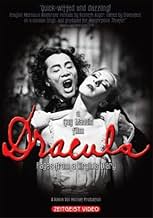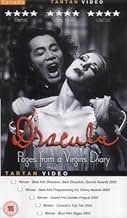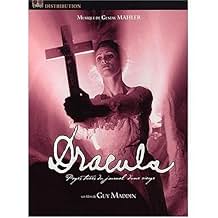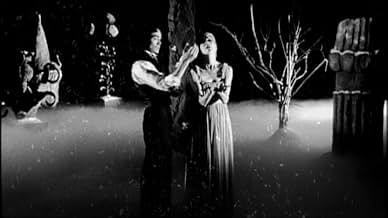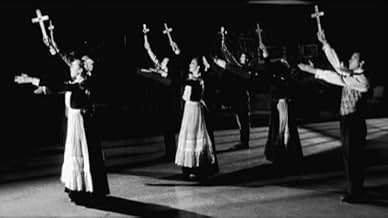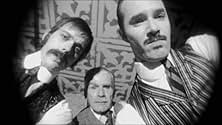VALUTAZIONE IMDb
6,8/10
2312
LA TUA VALUTAZIONE
Aggiungi una trama nella tua linguaA ballet rendition of Bram Stoker's "Dracula", stylized as an Expressionistic silent film.A ballet rendition of Bram Stoker's "Dracula", stylized as an Expressionistic silent film.A ballet rendition of Bram Stoker's "Dracula", stylized as an Expressionistic silent film.
- Premi
- 4 vittorie e 2 candidature totali
Wei-Qiang Zhang
- Dracula
- (as Zhang Wei-Qiang)
Johnny A. Wright
- Jonathon Harker
- (as Johnny Wright)
Recensioni in evidenza
Lucy Westernra is engaged to marry Lord Arthur Holmwood. However, an evil comes out of the east. She is bitten by Dracula. Vampyr-hunter Abraham Van Helsing arrives to clear out her polluted blood. Mental patient Renfield's escape leads to a massacre. Dracula reanimates Lucy. Van Helsing and the men hunt for Lucy and then finally Dracula himself.
Filmmaker Guy Maddin continues his experimentation. This is mostly black and white with splashes of bright colors. It is a silent film with many of its conventions such as title cards and era appropriate special effects. The ballet dancing can be hypnotic. The story follows the traditional Bram Stoker's Dracula with its xenophobia. It is definitely not for everyone and my fascination with the movie does wear out in the second half. Nevertheless, this is a worthy experiment.
Filmmaker Guy Maddin continues his experimentation. This is mostly black and white with splashes of bright colors. It is a silent film with many of its conventions such as title cards and era appropriate special effects. The ballet dancing can be hypnotic. The story follows the traditional Bram Stoker's Dracula with its xenophobia. It is definitely not for everyone and my fascination with the movie does wear out in the second half. Nevertheless, this is a worthy experiment.
I had the pleasure of witnessing the world television premiere of this wonderful film last night. It had been a five-year wait since Maddin's last feature length effort, the disappointing "Twilight of the Ice Nymphs", so I waited with baited breath. It is with great satisfaction that I announce that Maddin is back in full form with his fifth feature, and twenty-second film over all. Told in Maddin's trademark, fever dream style, the film harkens to the cinematic days of yore (mostly in black and white, no spoken dialogue, only titles), and yet is at the same time fresh, intelligent, and energetic. Maddin fans will not be disappointed. Fans of the 1998 Royal Winnipeg Ballet, from which this film was adapted, might be surprised to see what Maddin has done. He has seamlessly blended the ballet with the narrative action, so neither distracts or takes away from the other. This is no "filmed ballet" (see Nureyev's 'Romeo and Juliet'). The camera moves freely, and Maddin's use of different film stocks and depth of field create an otherworldly atmosphere. Possibly the best way to enjoy this film however, is as a fan, or at least connoisseur, of the Original Bram Stoker novel on which both the film and the ballet are based. Maddin remains 100% faithful to the story. All the characters and event in the book are here, although Maddin is able to compress the information to its barest essentials (Jonathan Harker's invitation to Castle Dracula, his imprisonment, and subsequent escape, is told in one delirious, incredible montage lasting less than a minute). However, Maddin subverts the themes (or perhaps brings out the dormant themes) of the original to create a whole new take on the book. Dracula fans should find this fascinating. Of course, I've lavished all this praise on Maddin, but I must give credit where credit is due. The dancers (whom Maddin did not cast, as they were all in the original stage production) wonderfully evoke their characters without dialogue, through dance alone; something were not used to seeing in film. As I have said before, the dance and filmic elements work in perfect tandem. All in all this film gives us something new as Maddin lovers, Ballet lovers, Dracula lovers, or all three. It is a feverish orgy of the best things art has to offer. Bravo! Encore!
I really had no idea what to expect coming into this film. I had heard basically nothing about it other than it's good ratings, recommendation from Ebert, and I have been interested for a while now in Guy Maddin. This is my first time watching one of his films and I am borderline speechless. I didn't know he primarily works in the silent genre and to top that, this film is entirely a ballet. Filmed in mostly black and white with silent era techniques, Maddin creates and eerie mood with this take on Brom Stoker's classic novel. I've never seen anything quite like it. It sometimes looks like it from the silent era. It's impressive. My one complaint is the jumpy nature of the camera. I was sometimes focused on his dizzying camera work than what was going on, but still a very refreshing and awakening experience.
What an absolute thrill, from start to finish, just experiencing the `artistic conception' of this reverent homage to silent film, featuring Canada's Royal Winnipeg Ballet, a stunning performance by Zhang Wei-Qiang as Dracula, and the brilliant production design of Deanne Rohde. Once again, Guy Maddin has created a unique, conceptualized universe all his own; there's nothing else in cinema quite like his eerie, dreamlike imagery. This film is immersed in the thundering power of Mahler's `Resurrection' 2nd Symphony, a work which itself features an ascension from all things human and earthly, and rises into the glorious heavens, a transcendent experience which, musically, grounds this film. From this theme, we add vampires, whose lust for blood promises life everlasting. The performance of Zhang Wei-Qiang dominates throughout, as he is easily the most fascinating stage personality, filled with a mesmerizing ability to seduce and ultimately possess his willing screen sirens, and while I can't speak for anyone else, I always root for him against his puritanesque nemesis, Dr Van Helsing, the leader of the repressed gang of vampire slayers. Ballet director Mark Godden choreographed the ballet adapted by Maddin for this film, so there is constant motion on screen. All this is done in image and in dance, with exaggerated gestures and with an extreme grace in movements, magnificently sensuous and macabre, shrouded in fog and black and white shadows, with only the tiniest color tints. Each frame, by itself, is a still masterpiece; the imagery is that overpowering. But when put in motion by such gifted hands as Maddin's, the film experience is indescribable, but unforgettable.
I am completely revising my must see list after watching this. I know only one other of Maddin's projects, his "Saddest Music in the World" of the next year. I rated that in my category of films you must see.
The rules of that list are that no more than two films per year, nor no more than two per filmmaker can be on it. This almost bumped "Talk to Her" off that list. It may yet. Let me advise you now that this is powerful and important stuff, the only successful marriage I know of literature, dance and film. In fact I know few that successfully integrate any two, much less masterpieces in each medium.
The story itself is greatly enriched: all the most terrifying horror is beautiful, and this is: an arc of desire across your life for that hour and a half. Where the original was only about sex, this is written larger to race, money, power and all in an erotic context that transcends sex. You'll notice when seeing this that it is more true to the book than any other filmed version.
Now just think for a moment about this: Dracula has been filmed by Murnau, Browning, Warhol, Herzog, Franco, Coppola and herds of lesser lights. No where has the scope been this broad and sharp.
(The device of the diary has been changed from the detective's to the virgin's, a master concept that indicates the deep thought that went into this. Exposure to that diary makes the girlfriend sex-crazed, for instance, as if the art itself were the infected blood.)
The dance. The choreographer has put together something that is remarkable, even seen merely as a ballet. It uses Mahler's music, by the way. That music is usually so overtly ripe it smells of selfish world conquest. It says something that here it seems merely supportive, that what you see on the screen is bigger.
So the choreography affects powerfully but what matters is the cinematic rendition. This is far more evocative as filmed ballet than a live performance can ever be, because we are allowed to have our eyes dance as participants. When a character's eyes flutter and question, ours do too. When the dance suggests a motion, it is us that completes it or gives it a resting place. The integration of choreography and cinematography is the best I have ever had in my life: beyond the sheer energy of "Red Shoes" to intimacy.
But it is the other cinematic qualities that make this unique. Dracula is a powerful story only because it evokes notions of the past that have power to awaken and live in our souls. Those notions are like the vampire and carried by him in the story. Once we touch them -- have sex with them, we are infected, transformed.
How to convey that cinematically? Why by evoking old film techniques as the story did literary ones. (Today that evocation by hacks is inaptly called "gothic.") So we have a silent film. Actually a postmodern comment on a silent black and white film. Lots of reminders of the camera in cropping and Vaselined lenses. Occasional tinting (blood and lucre), overtly theatrical sound effects, wobbling when we have to move quickly (or die).
The gauzy camera lens is made three dimensional with fog that extends the blur as the camera motion is also made three dimensional by the moving crowd. The whole thing has a phrasing and rhythm that is so well integrated among the dance, light, camera, story and music it is as if the things coevolved from the big bang.
Whoever did the art design deserves a reward. The sets are organic and in the last half in the lair, overtly vaginal -- so overtly it shocks. It must have been drawn at the same time as the choreography.
There's sex and beauty and seduction here. Be seduced my friends. Succumb. Art requires seduction and in the process some infection of urges. It is all about the dance -- Succumb, dance, die.
Ted's Evaluation -- 3 of 3: Worth watching.
The rules of that list are that no more than two films per year, nor no more than two per filmmaker can be on it. This almost bumped "Talk to Her" off that list. It may yet. Let me advise you now that this is powerful and important stuff, the only successful marriage I know of literature, dance and film. In fact I know few that successfully integrate any two, much less masterpieces in each medium.
The story itself is greatly enriched: all the most terrifying horror is beautiful, and this is: an arc of desire across your life for that hour and a half. Where the original was only about sex, this is written larger to race, money, power and all in an erotic context that transcends sex. You'll notice when seeing this that it is more true to the book than any other filmed version.
Now just think for a moment about this: Dracula has been filmed by Murnau, Browning, Warhol, Herzog, Franco, Coppola and herds of lesser lights. No where has the scope been this broad and sharp.
(The device of the diary has been changed from the detective's to the virgin's, a master concept that indicates the deep thought that went into this. Exposure to that diary makes the girlfriend sex-crazed, for instance, as if the art itself were the infected blood.)
The dance. The choreographer has put together something that is remarkable, even seen merely as a ballet. It uses Mahler's music, by the way. That music is usually so overtly ripe it smells of selfish world conquest. It says something that here it seems merely supportive, that what you see on the screen is bigger.
So the choreography affects powerfully but what matters is the cinematic rendition. This is far more evocative as filmed ballet than a live performance can ever be, because we are allowed to have our eyes dance as participants. When a character's eyes flutter and question, ours do too. When the dance suggests a motion, it is us that completes it or gives it a resting place. The integration of choreography and cinematography is the best I have ever had in my life: beyond the sheer energy of "Red Shoes" to intimacy.
But it is the other cinematic qualities that make this unique. Dracula is a powerful story only because it evokes notions of the past that have power to awaken and live in our souls. Those notions are like the vampire and carried by him in the story. Once we touch them -- have sex with them, we are infected, transformed.
How to convey that cinematically? Why by evoking old film techniques as the story did literary ones. (Today that evocation by hacks is inaptly called "gothic.") So we have a silent film. Actually a postmodern comment on a silent black and white film. Lots of reminders of the camera in cropping and Vaselined lenses. Occasional tinting (blood and lucre), overtly theatrical sound effects, wobbling when we have to move quickly (or die).
The gauzy camera lens is made three dimensional with fog that extends the blur as the camera motion is also made three dimensional by the moving crowd. The whole thing has a phrasing and rhythm that is so well integrated among the dance, light, camera, story and music it is as if the things coevolved from the big bang.
Whoever did the art design deserves a reward. The sets are organic and in the last half in the lair, overtly vaginal -- so overtly it shocks. It must have been drawn at the same time as the choreography.
There's sex and beauty and seduction here. Be seduced my friends. Succumb. Art requires seduction and in the process some infection of urges. It is all about the dance -- Succumb, dance, die.
Ted's Evaluation -- 3 of 3: Worth watching.
Lo sapevi?
- QuizSarah Murphy-Dyson's debut.
- ConnessioniReferenced in Guy Maddin: His Winnipeg - in conversation with Charles Coleman (2014)
- Colonne sonoreSymphony #1 (excerpts)
By Gustav Mahler
I più visti
Accedi per valutare e creare un elenco di titoli salvati per ottenere consigli personalizzati
- How long is Dracula: Pages from a Virgin's Diary?Powered by Alexa
Dettagli
- Data di uscita
- Paese di origine
- Sito ufficiale
- Lingua
- Celebre anche come
- Drácula - El diario de una virgen
- Luoghi delle riprese
- Aziende produttrici
- Vedi altri crediti dell’azienda su IMDbPro
Botteghino
- Budget
- 1.600.000 USD (previsto)
- Lordo Stati Uniti e Canada
- 55.365 USD
- Fine settimana di apertura Stati Uniti e Canada
- 4784 USD
- 18 mag 2003
- Lordo in tutto il mondo
- 55.365 USD
- Tempo di esecuzione
- 1h 13min(73 min)
- Colore
- Mix di suoni
- Proporzioni
- 1.85 : 1
Contribuisci a questa pagina
Suggerisci una modifica o aggiungi i contenuti mancanti

